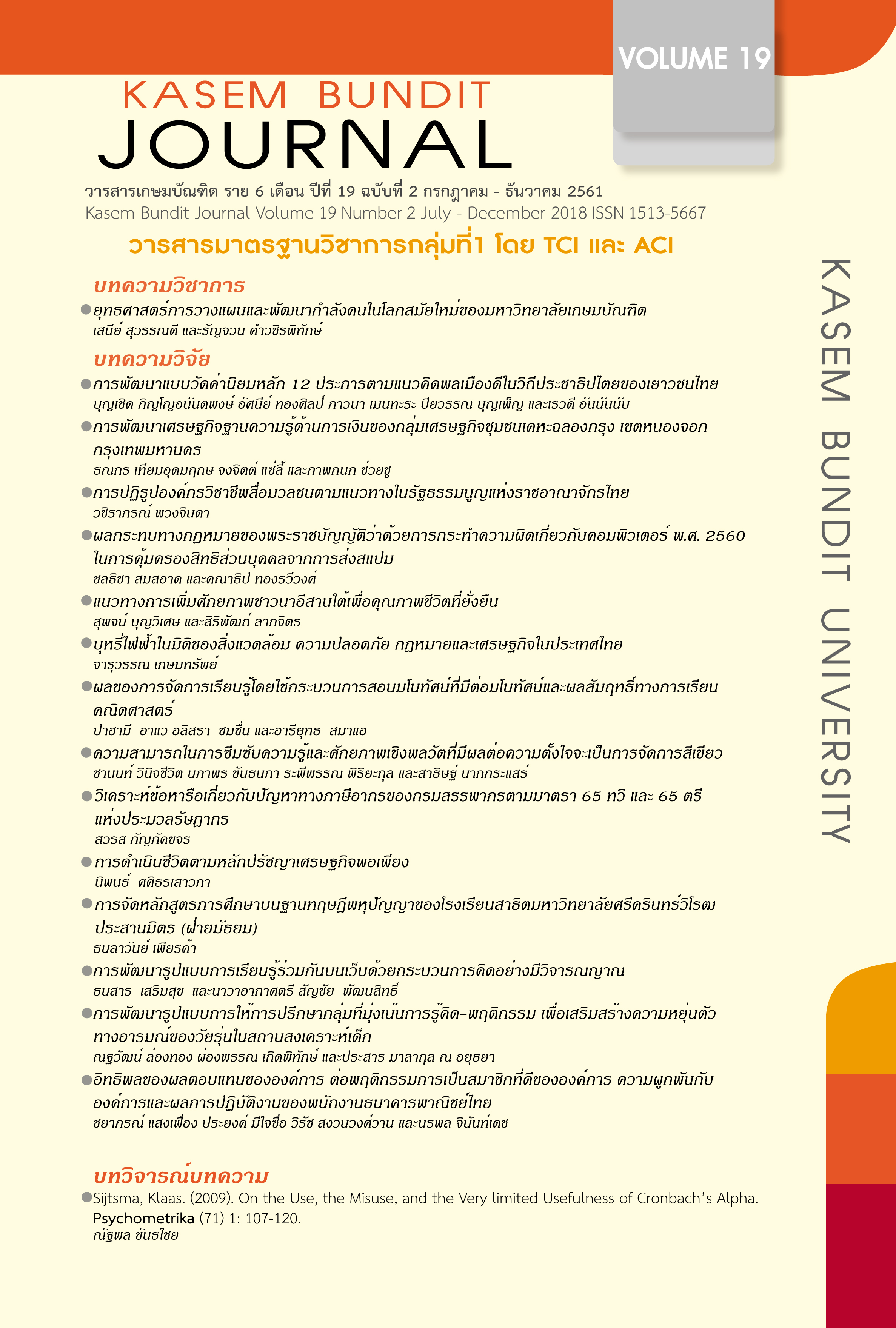การพัฒนาแบบวัดค่านิยมหลัก 12 ประการ ตามแนวคิดพลเมืองดีในวิถีประชาธิปไตยของเยาวชนไทย
คำสำคัญ:
การพัฒนาแบบวัด, ค่านิยมหลัก 12 ประการ, พลเมืองดีในวิถีประชาธิปไตยบทคัดย่อ
The research aims to develop the 12 National Core Values scale of the younger generation, namely Thai youth, in order to find norms to compare the average value scores of various schools. In addition, the research which is categorized as Research and Development (R&D) also aims to create a manual for comparisons. Sample groups are high school students of the 2015-2016 academic year; schools in the Bangkok metropolitan area are divided into state-run schools or universities and private schools. The sample size had 1,324 students to use the Multi-Stage system method. The Development of the 12 National Core Values Scale used the civil democracy idea. The results are as follows:
- The instrument includes situational parts 58 factors, 28 major behavior patterns. With regards to the answers on affective domain by Krathwohl (1964), comprise of level of understanding, response level, value creation level, habit level and the level of helping society. Results indicating showed validity evidence as follows. Index IOC is 0.76 – 0.96, CITC is appropriate. Each question has level of significance at 0.01. Cronbach Alpha coefficient equaled to 0.92. Exploratory Factor Analysis (EFA) showed that the MSA based on the KMO method had a value equaled to 0.83 which is acceptable. And the Bartlett’s Test of sphericity indicated a significant level at 0.01. Confirmatory Factor Analysis (CFA) showed that the Models have suitable with the empirical data.
- The Mean of value found that; the students in all classes have values of all aspects in receiving level, but grade 7 students, have 2nd value that is sincere, selfless and brave and 7th value that is democratical knowledge. These are in responding level. Grade 12 students have the 2nd values which in responding level. Each of values 1st-12nd normalized T-score are between T26–T81 and the total value is between T21 – T76
- Evaluation of the using test manual from high school teachers found that; Overview, They have high satisfaction level. In each case, the quality measurement phase is the highest level. Subordinate levels are the Structural phase and measurement method phase.
เอกสารอ้างอิง
Arechep, Kanjana and Prachusilpa, Gunyadar. (2007) Development of Competency Assessment Scale for Head Nurse. Siriraj Nursing Journal,1(2).
Bloom et al. (1956) .Taxonomy of educational objectives: Handbook I. The cognitive domain. [Retrieved]
Chareekue, Saman (2523). Relationship between social values and honesty. Master's degree (Sr.), Srinakharinwirot University.
Department of Academic Affairs (2554). Basic Education Curriculum BE 2001. Bangkok: Academic Quality Development.
Geisert, Paul. (1972). The Dimensions of Measurement of the Affective Domain. College of Education Center for Research,Service and Publication University of Wyoming Laramie, U.S.A.
Ebel, Robert L. (1951). Estimation of the Reliability of Ratting. New York: Hlot, Rinehart and Winston.
Hair et al. (1995). Preparation of the Analysis. [Retrieved] from https://www.springer .com/978-3-642-18043-9
Hanakin, Panas (2520) Teaching values. Phitsanulok. Documentation and printing Srinakharinwirot University.
Jiraporn Petdom and Paiboon Yamkasikran (2011): Risk Factors Affecting Deviation Behaviors of Secondary School Students in Nakhon Nayok Province. [Retrieved]
Karen Neuman Allen, Bruce D. Friedman. (2010). Affective learning: A taxonomy for teaching social work values. Bakersfield Journal of Social Work Values and Ethics, 7(2).
Khammani, Tisana et.al. (2542). Learning to Develop Thinking Process. Reform of learning based on 5 theories. Bangkok: Idea Square.
Krathwohl, D. R., Bloom, B. S., and Masia, B. B. (1964). Taxonomy of educational objectives Handbook II The affective domain. New York McKay
Nichanun Pipatnpakorn (2012) Attitude toward morality, ethics, values and desirable characteristics of students. High Vocational Certificate Uttaradit Technology College, Academic Year 2557. [Retrieved] on January 20, 2017 from https://www.pvca-ri.com/myfile/010116163635_1.pdf.
Nunnally, Jum C, Bernstein, Irah. (1994) .Psychometric Theory. 3 rd (Ed.), Now York: Mc Graw-Hill.
Phramaha Arjariyaphong Khamtuan (2011) The practice of ethics, morals and desirable values of secondary school students in Nakhon Pathom province. [Retrieved] https://odpc9.ddc.moph.go.th
Rovinelli, R.J.,& Hambleton, R.K.(1976).On the use of content specialists in the assessment of criterion-referenced test item validity. Dutch Journal of Educational Research,2,49-60. [Retrieved] from https://files.eric.ed.gov/fulltext/ED121845.pdf
Samodjag, Phubetr and Kanganachit, Monsikarn (2011). Consumer Behavior in Thai Adolescents and the Factors that cause it. Thammasat University Journal, 33 (1)
: 46-69.
Sainumparmerape, Pacharat. (2550). An Analysis of Characteristics of Teachers Quality in Educational Reformation Perceived by Teachers under the Office of Secondary Education Region 39. (Master Thesis Educational Research and Evaluation, Naresuan University.
Srisaard, Boonchom. (no date). Measurement of psychosocial features. [Retrieved] Search from www.watpon .com /boonchom/09.doci
Sinthuwong, Parichat.(2554). Meaning of Status, Role, Rights, Liberty and Duty, Good Citizenship [Retrieved] from https://parichut.wordpress.com/category/
The Secretariat of the House of Representatives (2555). Inspiration: Values.
Unhasuta, Krongdai. (no date). Evaluation based on learning behavior. Department of Nursing. Pages 1-8 [Retrieved] https://www.ns.mahidol.ac.th/english/th/degree_bns.
ดาวน์โหลด
เผยแพร่แล้ว
รูปแบบการอ้างอิง
ฉบับ
ประเภทบทความ
สัญญาอนุญาต
ทัศนคติ ความคิดเห็นใด ๆ ที่ปรากฏในวารสารเกษมบัณฑิตฉบับนี้เป็นของผู้เขียน โดยเฉพาะ มหาวิทยาลัยเกษมบัณฑิตและบรรณาธิการ ไม่จำเป็นต้องมีความเห็นพ้องด้วย







